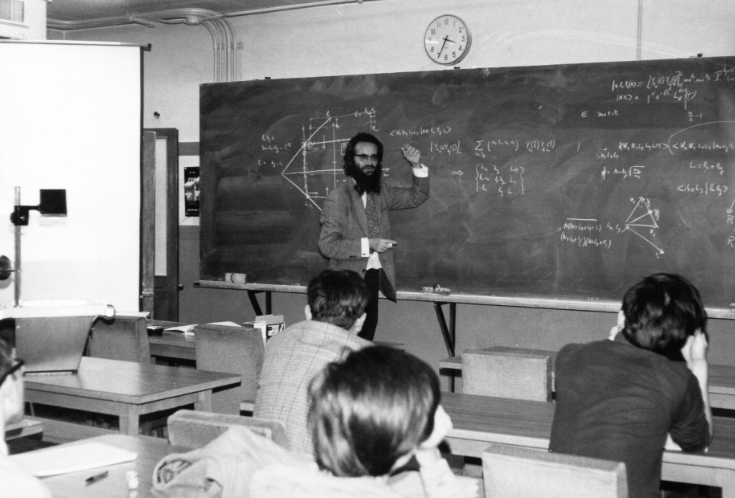MBPT, EFT, EDF
Le Larsim et l'ESNT Projet nucleAI Post-doctorants-visiteurs Visiteurs Publications Post-doc Call 2021 Informations pratiques - Practical informationJacques RAYNAL
Jacques Raynal (born in 1934; left us in 2020) was a physicist working in nuclear reaction theory at the Department of Physics Theory (IPhT, ex-SPhT) of CEA Saclay, from 1974 till 1996. From 1994 till 2020, as a scientific advisor of the Nuclear Physics Departement (SPN) of CEA-DAM at Bruyères-le-Châtel, he continuously worked on nuclear reactions problems and pursued his developments of new versions of his famous codes for DWBA calculations (DWBA07) and for coupled-channel calculations, ECIS.
TOPICS OF INTEREST AND WORKS, CODES and ARTICLES
|
Jacques giving a lecture. |
For a detailed review of his works and of his impact on the research field of the nuclear reaction theory, a topical issue of The European Physical Journal A, "Nuclear Reaction Studies: a Tribute to Jacques Raynal" is published on:
https://epja.epj.org/component/toc/?task=topic&id=1282
The articles show the posterity of his works and codes.
The editorial - preface of this topical issue can be found at : https://doi.org/10.1140/epja/s10050-021-00596-4
and here:  EPJAprefaceRAYNALsept2021.pdf
EPJAprefaceRAYNALsept2021.pdf
Jacques Raynal performed a series of early studies on specific formalism aspects of the nuclear reactions:
+ Helicity formalism for nuclear reactions [Raynal67];
+ Spin-orbit interaction in inelastic Nucleon Scattering and parameters of the Optical Model Potentials (OMP);
+ First developments on the CC codes for OMP calculations of nuclear reactions, that he explained during the lectures he gave at Trieste in 1971 [Raynal71];
+ First developments on what would become the ECIS code: J. Raynal, Notes on ECIS-79 (May 25, 1982).
In the years 1969-1971, J. Raynal worked on 3-body approach with Janos Revai. The Raynal-Revai (RR) coefficients were introduced in the article published in 1970 [RR70].
Nuclear reaction codes
Jacques Raynal explained the numerical algorithms developed for the ECIS code, "Équations Couplées en Itérations Séquentielles", "Coupled Equations in Sequential Iterations" in his review article [Raynal81] quoted in every paper using the ECIS code.
The next versions were ECIS86, elaborated to include the treatment of vibration excitation modes and ECIS94, to improve the computing time of the Coulomb scattering problems.
New versions of the code were elaborated to solve physical problems submitted by his colleagues, nuclear physicists working in the experimental analysis or in the field of the nuclear data evaluation.
Jacques Raynal also developed other codes to perform calculations with optical model potentials in the Distorted Wave Born Approximation (DWBA): there was the DWBA91 code used for the analysis of nucleon-nucleus scattering, followed by new versions in 2005 and in 2007 [DWBA07], in particular to improve the computing operations for specific problems of elastic and inelastic scattering
with nucleon-nucleon potentials.
Dirac formalism
To analyze the nucleon-nucleus scattering at high energies (several hundreds of MeV), in particular for inelastic scattering with polarized protons, Jacques Raynal developed codes including the Dirac relativistic formalism in coupled-channel (CC) calculations. The OMP parameters were carefully checked in this formalism [Raynal87-89] and the applications of the Dirac and Schrödinger formalisms were compared on several experimental results of proton scattering on stable targets, like 16O, 24,26Mg, 40Ca and sd shell nuclei. He worked also on the microscopic description of elastic and inelastic nucleon scattering investigated using the Dirac and Schrödinger formalisms [Scatt98-00].
A selected list of his publications and reports. (Click to see the list including the references quoted above)



